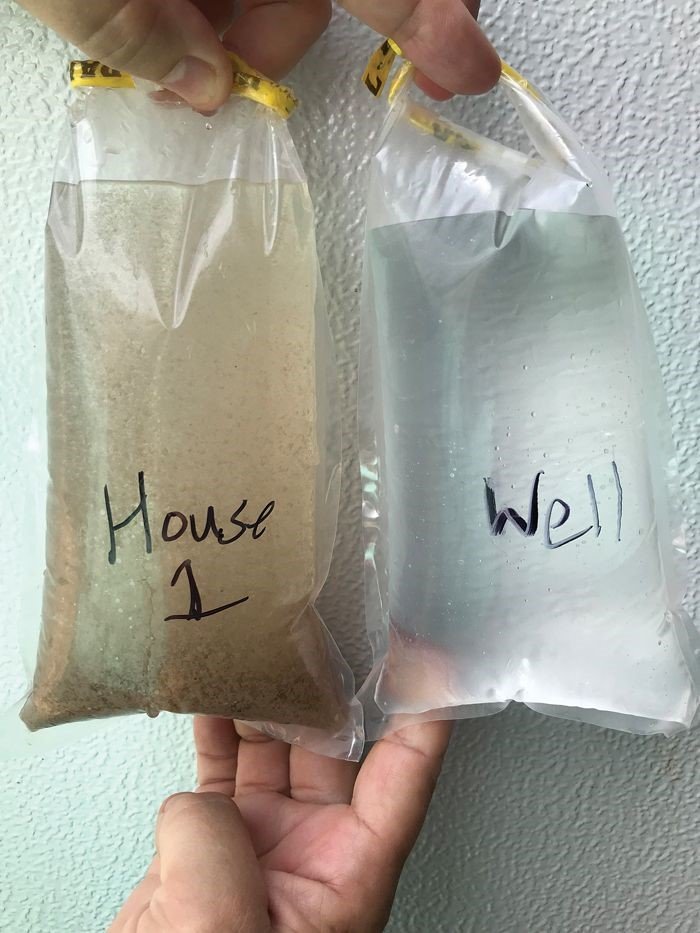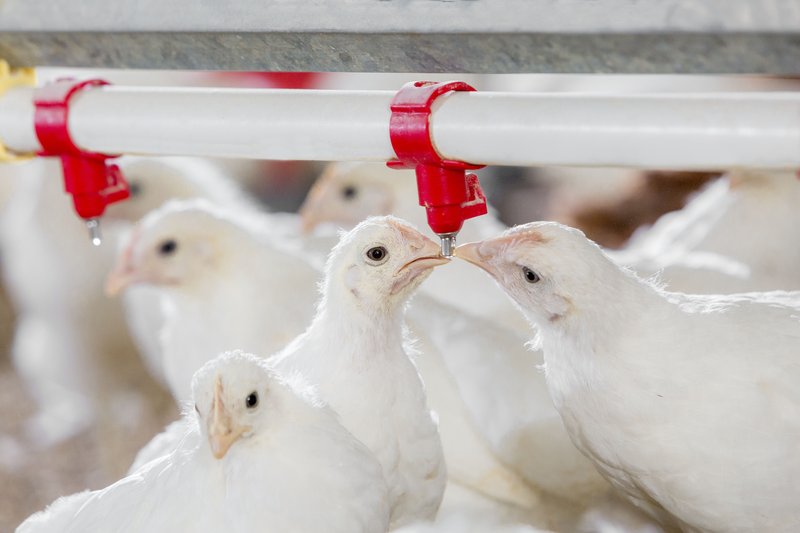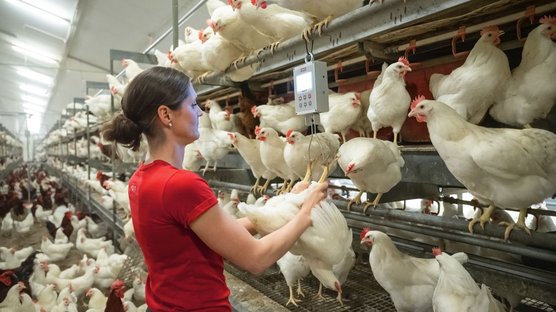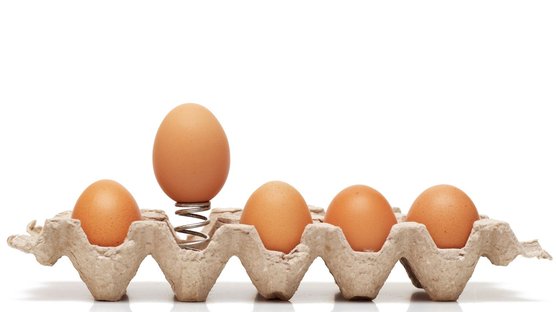
Published on Feb. 28, 2024
Good quality drinking water
Birds, at all ages, must always have easy access to clean, fresh and good quality drinking water. Good quality drinking water is clean, clear, fresh, tasteless and free from contaminants. The quality of the drinking water should be regularly checked as contaminated drinking water can cause serious disease problems. Never forget the importance of water: when birds don’t drink, they won’t eat and cannot grow or produce!
Water is an important nutrient
Often neglected as a source of nutrients, but water is a very important nutrient for all production animals. Birds consume at least 1.6 times more water than feed, with an increased amount during the period of reproduction organ development. The birds should be able to easily find, access and drink the water, besides they should be able to drink as much as they need at any time. Water intake stimulates feed intake and both water and feed are necessary for the birds’ development and the production of eggs. A decrease in water consumption can be an early warning that something is wrong with the health of your flock. Daily water monitoring is therefore an easy and clear monitoring tool.
Good quality water is important as water can also be used as a carrier for vaccines and antibiotics / chemotherapeutics. But on the other hand, it can also be an important source of pathogens! The goal is to keep your water free from biofilm, scale, bacteria, molds, fungus, algea and yeasts, while maintaining the correct chemical values as pH.
Visual inspection
The easiest and cheapest way to inspect the drinking water is by having a look at it. Collect water samples from the source (the well), a sample from the beginning of the water line in the poultry house, and a sample taken at the end of the line. Compare all samples with each other, this will help to understand where problems with water quality might occur. The source is not always the problem, often the water lines inside the barn can cause problems, e.g. biofilter causing discoloration or debris.
Relatively cheap and easy method is to make use of an inspection camera, these cameras can be used to go inside the water system itself and have a closer look what the situation is inside the system.

Comparing water from the source, vs. water coming from the end of the drinking lines in the barn.
Know what your birds are drinking
Soluble minerals can easily make interactions in water, this can reduce the absorption of other minerals found in water and feed, therefor certain minerals in drinking water can have an indirect negative effect. For example, it is known that high iron and calcium levels can lead to deficiency of other minerals. From several minerals it is known that they can have a direct effect in the performance of the laying hens, high sodium levels can cause wet litter whilst high magnesium levels can decrease eggshell quality. It is also known that abrupt fluctuations in water pH can affect the intake of water.
| Parameter | Good Quality | Do not use |
|---|---|---|
| pH | 5 – 8 | < 4 and > 9 |
| Hardness in German degrees | > 4 < 15 | > 20 |
| Physical aspects | Clear, colourless and odourless | |
| Ammonium mg/l | < 1.0 | > 2.0 |
| Nitrite mg/l | < 1.0 | > 1.0 |
| Nitrate mg/l | < 100 | > 200 |
| Chloride mg/l | < 250 | > 300 |
| Sodium mg/l | < 100 |
> 200a > 400b |
| Sulfate mg/l | < 100 | > 250 |
| Iron mg/l | < 0.5 | > 1.0 |
| Manganese mg/l | < 0.5 | > 1.0 |
| Oxidizable organic matter mg/l | < 50 | > 200 |
| H2S | Non detectable | Non detectable |
| Coliform bacteria CFU/ml | < 100 | > 100 |
| Total germ count CFU/ml | < 100.000 | > 100.000 |
a for laying hens under 20 weeks of age
b for laying hens above 20 weeks of age
Source: GD Animal Health
Water source and drinking system
The water quality also depends on the source of water, type of drinking water system used in the houses (storage vessels, pipelines, drinkers) and hygiene of the water system. Make sure the water system is closed and cannot be contaminated from the outside. When using storage vessels, pay extra attention to the quality of these vessels.
When using municipality water, it is important to discuss the water sources with your supplier. In general municipality water has different origins, and therefore the water quality could fluctuate more. Borehole water sometimes needs some treatments to make it suitable for drinking. Surface water should never be used as a source for drinking water, because of the risk of contamination with bird pathogens. Wild waterfowl travel freely over the globe, carrying diseases with them (i.e. avian influenza) and dropping large amounts of contaminated droppings on their resting places along their way.
The water system in the houses should be regularly cleaned and disinfected. It should always be disinfected in-between flocks and after water treatments. To keep the water system clean in longer production periods it is important to check the water system regularly. If needed it can also be cleaned during production. Make sure that the water systems are working properly after cleaning.
Biofilm
A biofilm is a layer of microorganisms contained in a matrix(slime layer), which forms on surfaces in contact with water. Their presence in drinking water pipe networks can be responsible for a wide range of water quality and operational problems.
Dirty water systems are indicators for the presence of biofilm, and biofilm is the ideal place for pathogens to thrive. Biofilm can be extremely persistent, and has the ability to grow back in just 3 – 5 days. Daily sanitation and line cleaning is essential in your drinking water management. To reduce the growth of biofilm, prevent slow-moving water (or water standing still) and prevent the water from getting warm.
Water treatment
A good water treatment program needs to effectively treat water coming into the poultry houses, and keep it clean all the way up to the end of the drinking water supply in the poultry house. Your water treatment program should complement the water and make the quality consistent over time. Monitoring the water quality before and after water treatment should be part of your program.
Sanitizing the water system during the rearing period can be a risky exercise. In general, a good cleaning of the system in the empty period should be sufficient for the whole 16 weeks rearing period and the rearing birds should get the chance to build up some immunity against normal environmental bacteria’s like E. coli. Semi-continuous use of water sanitizers can interfere with this.
Different products can be used for cleaning the system, both in-between flocks, when the houses are cleaned and disinfected, and during the production. These products can contain (combinations of) acetic acid and hydrogen peroxide, chlorine, organic acids and inorganic acids. Be careful of the percentages used when using these products in drinking water. Also be careful with the taste and with the acidity of the water. Using acids, pH should be below 4, to achieve the disinfecting effect and above 3.5, otherwise it becomes corrosive and the birds stop drinking. High levels of chlorine have the same effect on the birds. To have an efficient disinfection with chlorine, decrease the PH. There must be no organic matter in the water, and a low iron and manganese concentration: if these conditions are not met, a proper water disinfection with chloride is not efficient. Using only organic acids as a water sanitizer for a longer period can be dangerous. You can see growth of yeasts and moult in the water. It is better to use acids and chlorine alternatively. However, always keep in mind the instructions and dosage of the supplier of the products.
Tip: Adding natural dye to the cleaning products that you enter in the water line will allow you to monitor the flow of the cleaning products. You can easily check if it reached the end of the line, and next to that, also when it is completely removed from the water drinking system.
Water analysis
In order to know the drinking water quality that is provided to your hens, you can analyse the water. A proper analysis starts with good sampling and storage conditions. In total 2 litres of water should be enough to do both a chemical and microbiological analysis. The frequency of checking should be at least once every 3 months. When checking water quality, it is important to check the water that your birds are receiving, as most contamination occurs via the drinking water system and not necessarily at the source. In the table below we give some simple indicators and tools to estimate the drinking water quality.
|
Estimation of water quality |
|
|---|---|
| pH | pH meter or pH paper |
| Conductibility | Conductibility meter |
| Hardness |
Calcium sediments at the nipples, tap or in water cooker |
| Visual check | Clarity, sediment, biofilm |
| Odor |
Sulphur, faecal contamination, |
| Taste | salty |
An easy checklist for water supply towards your birds
- Is the water according to the recommendations?
- Can the birds easily find and drink the water?
- For day-old chicks, is there enough light to find the water from the start?
- Is the water fresh (e.g. has the system been flushed shortly before the delivery of the day-old chickens)?
- Is the height of the drinkers correct? (adjust it over time as the chicks will grow)
- Is the system of the drinkers used the same during the different phases of production (rearing versus lay)?
- Are bell drinkers used or nipple drinkers, what was used in rearing?
- What kind of nipples?
- Can the small birds easily activate the nipples?
- What is the nipple flow rate?
- Are there enough drinkers/nipples per bird installed?
- What is the water pressure?
Always clean carefully your water systems between flocks, but be cautious when leaving organic acids in mixing tanks and the drinking lines. These acids may results in slime and therefor biofilm issues. Always flush the drinking lines prior the new flock enters the barn. In this way you still have time to solve any issue with the drinking lines and the quality of the drinking water.




